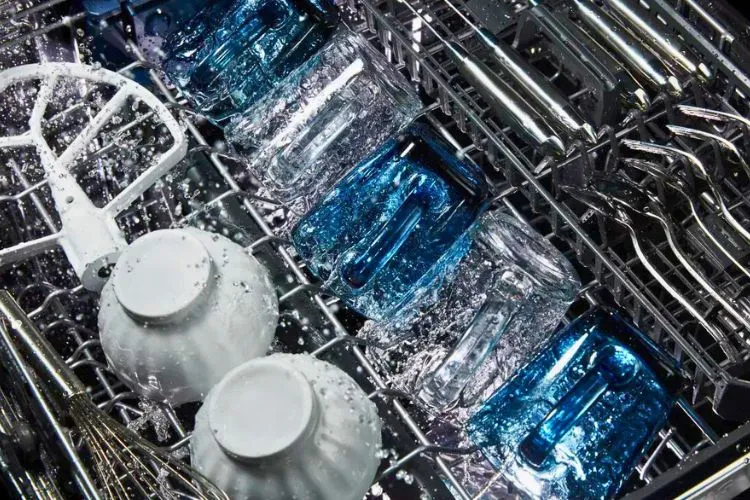Dishwashers have become an essential appliance in many households, streamlining the task of cleaning dirty dishes through automated processes.
But, does a dishwasher heat its own water as well?
This article seeks to address that query, diving into the mechanics of water heating within a dishwasher and its implications on efficiency and sanitation.

How Dishwashers Work?
A dishwasher operates through a series of controlled steps to ensure dishes come out clean and sanitized. It begins with water inflow, where water from your household supply enters the machine.
Instead of relying solely on this water, most modern dishwashers come equipped with their own heating element. This vital component enhances the cleaning process in various ways.
Water Inflow
Typically, a dishwasher connects to the home’s water supply, drawing cold or lukewarm water into the unit. The amount of water needed for a cycle can vary depending on the model and settings chosen.
Heating Mechanism
Inside the dishwasher, an embedded heating element raises the temperature of the incoming water. Elements might vary from exposed ones to in-line heaters, but all serve the purpose of heating water to the optimal temperature required for the dishwasher to perform effectively.
Thermostat Regulation
A thermostat within the dishwasher ensures that the water temperature remains at a consistent level. This device adjusts the heating element’s function to maintain the desired heat, which is crucial for both cleaning power and energy efficiency.
Does A Dishwasher Heat Its Own Water?
The choice to heat water directly within the dishwasher lies in the pursuit of efficiency and effectiveness. With warm water, detergent dissolves quickly, cutting through grease and oil with greater ease.
Moreover, the heat is necessary to kill off harmful bacteria, ensuring your dishes are not only visually clean but also sanitized. Additionally, having control over water temperature ensures consistency with each wash.
Energy and Water Saving
When compared to hand washing, dishwashers demonstrate a remarkable capacity to save energy and water. Modern units are designed with efficiency in mind, often meeting rigorous energy star ratings.
To further enhance this, operating the dishwasher at full load and choosing eco-friendly settings can contribute to noticeable savings.

Pros and Cons of In-Built Heating
Having a built-in heating mechanism comes with its own set of advantages. It ensures the right conditions for optimal cleaning and permits a high level of sanitization.
However, it might also mean higher energy use. Being aware of this allows users to weigh the benefits against possible increased electricity costs.
Maintenance and Troubleshooting
Maintaining your dishwasher’s heating element and thermostat is key to longevity and performance. Regular check-ups help prevent issues, but when problems arise, there are signs, such as dishes that are not properly cleaned or remain cold after a cycle completes.
Basic steps, such as checking for obstructions and ensuring that the appliance settings are correct, are the first line of defense in troubleshooting. However, when these measures fail, it is wise to call a professional.
Pro Tips
To get the best from your dishwasher, consider the manufacturer’s recommendations for water temperature settings. Choosing the right detergent and maintaining the device will enhance its performance.
By understanding how your dishwasher works, you can ensure it runs effectively while using heated water optimally.

Signs of a Failing Dishwasher Heating Element
- Dishes Not Drying Properly: Lack of heat leaves dishes wet post-cycle.
- Water Doesn’t Heat: The wash cycle runs with cold or lukewarm water.
- Visible Damage: Cracks or blisters on the element suggest failure.
- Increased Cycle Times: Heating issues can prolong the dishwashing process.
- Error Codes: Modern dishwashers may display specific error messages.
- Unusual Noises: Sounds of popping or cracking during operation.
- Higher Energy Bills: Inefficiency in heating can lead to increased energy use.
Energy-Saving Tips for Dishwasher Water Heating
- Use Eco Mode: Select energy-saving cycles which use less heat.
- Connect to Hot Water: Directly connecting to a hot water supply reduces heating demands.
- Load Efficiently: Maximizing each cycle’s load reduces the number of cycles needed.
- Maintain Regularly: Keep the heating element and dishwasher clean to ensure efficiency.
- Insulate Hot Water Pipes: To minimize heat loss from the water heater to the dishwasher.
- Pre-Rinse with Cold Water: If pre-rinsing dishes, use cold water to save energy.
Frequently Asked Questions (FAQs)
Can using hot water input damage the dishwasher’s heating element?
No, using hot water input should not damage the dishwasher’s heating element. Dishwashers are designed to accommodate hot water supply and regulate internal temperatures as needed.
What is the typical temperature range a dishwasher heats water to?
The typical temperature range a dishwasher heats water to is between 120°F to 150°F (49°C to 65°C). This range is optimal for dissolving detergent and sanitizing dishes.
How much energy does a dishwasher use to heat water?
The amount of energy a dishwasher uses to heat water varies by model but typically represents a significant portion of the dishwasher’s total energy consumption, often around 80% depending on the efficiency of the unit.
Why might some people prefer to connect their dishwasher to hot water directly?
Some people prefer to connect their dishwasher to hot water directly to reduce the dishwasher’s energy use for heating water, which can speed up wash cycles and potentially lower energy bills.
Can I still use my dishwasher if the heating element is broken?
Yes, you can still use your dishwasher if the heating element is broken, but the dishes may not be as clean, and it won’t be able to sanitize the dishes effectively. The drying phase may also be less efficient.
How does water temperature impact common dishwashing problems like streaking or cloudiness?
Water temperature impacts dishwashing problems like streaking or cloudiness by affecting detergent performance. Too low temperatures can prevent detergent from dissolving properly, leading to residue and spots.
Will a dishwasher with a broken heating element still dry the dishes?
A dishwasher with a broken heating element may struggle to dry dishes completely because the heat aids in the evaporation process. You might find dishes are damper than usual at the end of a cycle.
Conclusion:
Understanding whether dishwashers heat their own water helps users make informed decisions about their appliance use and maintenance.
Having delved into the mechanisms, benefits, and considerations, it is clear that an inbuilt water heater plays a key role in the operation of a dishwasher.


